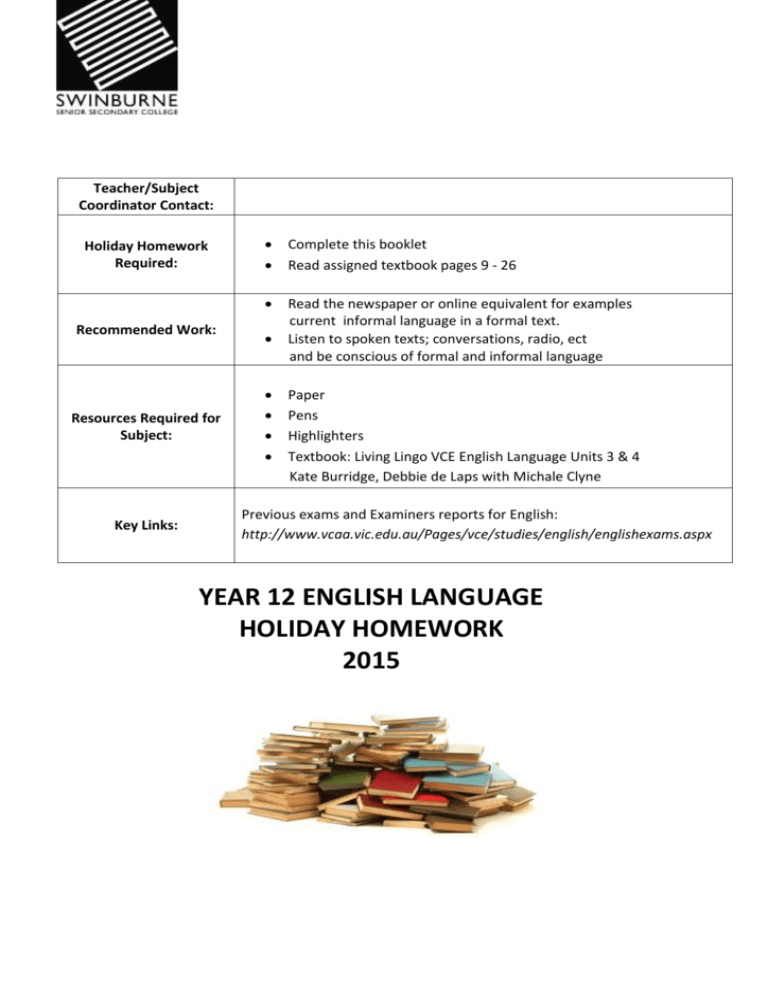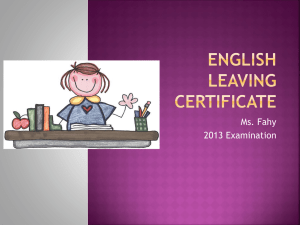Unit 3: Year 12 English Language
advertisement

Teacher/Subject Coordinator Contact: Holiday Homework Required: Recommended Work: Resources Required for Subject: Key Links: Complete this booklet Read assigned textbook pages 9 - 26 Read the newspaper or online equivalent for examples current informal language in a formal text. Listen to spoken texts; conversations, radio, ect and be conscious of formal and informal language Paper Pens Highlighters Textbook: Living Lingo VCE English Language Units 3 & 4 Kate Burridge, Debbie de Laps with Michale Clyne Previous exams and Examiners reports for English: http://www.vcaa.vic.edu.au/Pages/vce/studies/english/englishexams.aspx YEAR 12 ENGLISH LANGUAGE HOLIDAY HOMEWORK 2015 Unit 3: Year 12 English Language - Calendar WEEK 1 Orientation Jan 28- Jan 30 2 Feb 2 – 6 3 Feb 9 - 13 4 Feb 16 – 20 5 Feb 23 – 27 6 Mar 2 – 6 7Labour day Mar 9 - 13 8 Mar 16 – 20 9 Mar 23 – 27 Class content Introduction: Mode, domain, audience, field, What is Informal language Homework & Assessment Homework due at or before the beginning of class Skills Intro to using the textbook . Short answer test : 15 Marks Practice Expository essay HOLIDAY 10 April 13 – 17 Expository Essay: 35 Marks 11 Anzac day April 20 – 24 12 April 27 May 1 13 May 4 – 8 14 May 11 – 15 15 May 18 – 22 16 May 25 – 29 17 June 1 – 5 GAT week Queen’s birthday June 8 – 12 Intro to Formal Language Formal language Formal language Formal language . Formal language Practice analytical commentary Analytical commentary: 50 marks Mid-Year English exam June 9th Unit 4: Year 12 English - Calendar WEEK Class content 1 June 15 – 19 Intro to Language variation and Identity 2 June 22 – 26 Language variation and Identity Skills Homework & Assessment Homework due at or before the beginning of class HOLIDAY 3 July 13 – 17 Language variation and Identity 4 July 22 – 24 Language variation and Identity 5 July 27 – 31 Individual and group Identity 6 Aug 3 – 7 Individual and group Identity 7 Aug 10 – 14 Presentations begin 8 Aug 17 – 21 Intro to Individual and group Identity Expository essay Marks 20 Presentations Marks 30 9 Aug 24 – 28 10 Aug 31 – Sep 4 11 Sep 7 – 11 Language variation and Identity Language variation and Identity 12 Sep 14 – 18 Language variation and Identity 13 Oct 5 – 9 Exam Preparation 14 Oct 12 – 16 Exam Preparation 15 Oct 19 – 23 Exam Preparation Practice essay Expository essay response to a prompt: Marks 50 The subsystems of language used in the discipline of linguistics are commons to all Units of work. PHONETICS AND PHONOLOGY • prosodic features: pitch, stress, volume, tempo and intonation • vocal effects: coughs, laughter, breath • sounds in connected speech and connected speech processes: assimilation, vowel reduction, elision, insertion • features of Broad, General and Cultivated accents in Australian English • phonological patterning in texts: alliteration, assonance, consonance, onomatopoeia, rhythm, rhyme • an awareness of the International Phonetic Alphabet (IPA) and the phonetic transcription of English. MORPHOLOGY AND LEXICOLOGY • word classes: nouns, verbs, auxiliary verbs, modal verbs, adjectives, adverbs, prepositions, pronouns, conjunctions, determiners, interjections • function words and content words • affixation: prefix, suffix, infix • inflection and derivation • root, bound and free morphemes • suffixation in Australian English • word formation processes: blends, acronyms, initialisms, shortenings, compounding, contractions, collocations, neologisms • morphological and lexical patterning in texts. SYNTAX • phrases, clauses and sentences • sentence types and their communicative function in texts: declarative, imperative, interrogative, exclamative • the basic functions in clause structure: subject, object, complement, adverbial • sentence structures: sentence fragments; simple, compound, complex and compoundcomplex sentences; ellipsis; nominalisation; and coordination and subordination • active and passive voice, including agentless passives • syntactic patterning in texts: antithesis, listing, parallelism. DISCOURSE ANALYSIS • factors that contribute to a text’s coherence: cohesion, inference, logical ordering, formatting, consistency and conventions • factors that contribute to a text’s cohesion: information flow including clefting, front focus and end focus; anaphoric and cataphoric reference; deictics; repetition; synonymy, antonymy and hyponymy; collocation; ellipses; substitution; conjunctions and adverbials • features of spoken discourse: pauses, false starts, repetition, repairs, openings and closings, adjacency pairs, overlapping speech, interrogative tags, and discourse particles • strategies in spoken discourse: topic management, turn-taking, holding the floor, minimal responses • conventions for the transcription of spoken English. SEMANTICS • semantic fields • lexical choice and semantic patterning in texts: irony, metaphor, oxymoron, simile, personification, animation, puns, lexical ambiguity • lexical meaning, especially sense relations: synonymy, antonymy, hyponymy, idiom, denotation and connotation • euphemism and dysphemism. “Introduction” of Living Lingo- will document the above sections in detail download it at http://www.boobookeducation.com.au/images/Lingo_intro.pdf UNIT 3 – LANGUAGE VARTIATION AND SOCIAL PURPOSE. All language centres around social interaction. We will investigate English language in the Australian social setting, along a continuum of informal and formal registers. We will consider language as a means of societal interaction, understanding that through written and spoken texts to communicate information, ideas, attitudes, prejudices and ideological stances. We will consider how texts are influenced by the situational and cultural contexts in which they occur. We examine how function, field, mode, setting and the relationships between participants all contribute to a person’s language choices, as do the values, attitudes and beliefs held by participants and the wider community. AREA OF STUDY 1 Informal LanguageWe will investigate how speakers and writers choose from a vast repertoire of language in order to vary the style of their language to suit a particular social purpose. They consider the features and functions of informal language in written, spoken and electronic interactions, understanding that the situational and cultural context of an exchange determines the language used. For example, how do we distinguish between ‘chat’ and ‘being serious’? Outcome 1 On completion of this unit the student should be able to identify and analyse distinctive features of informal language in written and spoken texts. Assessment: Short answer test: 15 Marks Week of March 9 Essay: 35 Marks Week of April 13 AREA OF STUDY 2 Formal LanguageAs with informal language, the situational and cultural context determines whether people use formal language and in which mode they choose to communicate. Formal language in all modes, tends to be less ambiguous, more cohesive, and is more likely to make explicit aspects of the presumed context. We will investigate formal texts, explore how writers and speakers are more likely to consider how their audience might interpret their message, packaging it appropriately with attention to the art of rhetoric. We examine how formal written texts are more likely to have been edited while formal spoken texts may have been rehearsed. For both Outcomes we learn about the functions and features of texts in both areas and use the overarching themes of politeness and face, and the difference between Standard English an non standard Englishes On completion of this unit the student should identify and analyse distinctive features of formal language in written and spoken texts. Assessment: Analytical commentary: 50 marks Week of June 1 UNIT 4 LANGUAGE VARIATION AND VARIETY We explore how language use reflects and constructs identities. There is a particular focus on the connections in Australia between language use and ‘national identity’, and language varieties and individuals’ identities. Individuals’ identities are not fixed, but alter according to the ways in which they draw on their understanding of social expectations and community attitudes to shift their language style in a given context. Individuals’ identities are shaped by their capacity to access the overt or covert norms of a particular speech community. Outcome 1: Investigate and analyse varieties of Australian English and attitudes towards them. Assessment: Expository essay 20 Marks Week of July 27 Oral presentation: 30 Marks Week of 10 August Outcome 2: Individuals and group identities Analyse how people’s choice of language reflects and constructs Analyse how people’s choice of language reflects and constructs their identities. Expository Essay: 50 Marks Week of Sept 14 Examination – worth 50% of total assessment PLEASE COMPLETE: Set reading pages 9 – 26 as discussed at transition. Create notes or summaries for reading taking particular attention of ‘mode’, ‘field’, ‘audience’ and ‘locale’. Use note paper below. Informal language is a register used in a specific situation. In your home it is intimate and casual. You have established relationships between your guardian, parents, brother, sister. These relationships guide the language you speech. In he episode of Upper Middle Bogan we watched Wayne utters to the tv screen, in a drunken slur, ‘I luv ya’, Jules. I really luv ya.” This unit will look at the informality of language but cannot be defined of separated from formal language. See the ‘degrees of formality’ table in your textbook page 15. EACH TEXT WILL BE BROKEN DOWN INTO CATEGORIES: Upper Middle Bogan Domain: Entertainment Audience: General- demographic ABC 1 – educated, middle class etc (Later we will look into how socio-linguistics affects the interpretation of each text). Locale: Viewed in peoples homes, may be discussed at work or social situation reviews in tv magazines etc Field: Australian television comedy (domain and field coexist) Mode: Spoken, visual Spoken and written language, have functions which you will have to identify and describe throughout the year. More importantly, function, and the terms above should become part of your understanding and knowledge for the course, and used automatically in discussion and written work. (For spoken and written function s of language see tables 1 & 2 textbook pps 22-23. ‘Upper Middle Bogan’ ABC tv http://iview.abc.net.au/programs/upper-middle-bogan/CO1308V008S00 View the episode of ‘Upper Middle Bogan’ again. Describe each character by their accent and language. Use examples of words or repeated expressions. Jules Wheeler (blood mother of Bess) Bess (daughter) Margaret (Bess’ adoptive mother) Danny (Bess’ husband) Wayne Wheeler (Bess’ blood father) Amber, Kane, Madeline Wheeler Bess and Danny’s kids 1. Explain why there is a difference between each family. (For example, interests, occupation, education.) ________________________________________________________________________ ________________________________________________________________________ ________________________________________________________________________ ________________________________________________________________________ ________________________________________________________________________ ________________________________________________________________________ ________________________________________________________________________ How is language used to define each family? Do some of the characters sound ‘posh’ and others ‘bogan’? Why” ________________________________________________________________________ ________________________________________________________________________ ________________________________________________________________________ ___________________________________________________________________ Any other comments from the programme which can be connected to your reading? Notes on your reading








